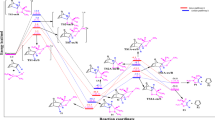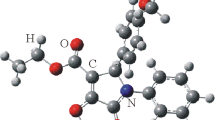Abstract
A computational investigation of anomeric effects in piperidine rings bearing fluoro and trifluoromethyl substituents shows for both compounds the most pronounced evidence of the anomeric effect, as expressed as hyperconjugative delocalization of the nitrogen lone pair, in structures with the substituent in the axial position and the N–H bond in the equatorial position. This structure is the lowest-energy structure in the fluoro case but not in the trifluoromethyl case where there is an increased axial penalty associated with the CF3 group. The anomeric effect is characterized via geometrical evidence, natural bond orbital analysis, electrostatic effects, and energetic criteria. Computational results from a variety of levels of theory are presented including CCSD(T) with complete basis set extrapolation, B2PLYP-D, ωB97XD, B97-D, M06-2X, B3LYP, and MP2 allowing for a comparison of performance. The CCSD(T)/CBS results are very well represented by either B2PLYP-D or ωB97XD with moderate to large basis sets (aug-cc-pVTZ or aug-cc-pVDZ). Hyperconjugation, electrostatic effects, and steric effects play a role in the relative energetic ordering of the isomers considered.






Similar content being viewed by others
References
Smart BE (2001) Fluorine substituent effects (on bioactivity). J Fluorine Chem 109(1):3–11
O’Hagan D (2008) Understanding organofluorine chemistry. An introduction to the C–F bond. Chem Soc Rev 37:308–319. doi:10.1039/b711844a
Hunter L (2010) The C–F bond as a conformational tool in organic and biological chemistry. Beilstein J Org Chem 6:38. doi:10.3762/bjoc.6.38
McKinney BE, Urban JJ (2010) Fluoroolefins as peptide mimetics. 2. A computational study of the conformational ramifications of peptide bond replacement. J Phys Chem A 114(2):1123–1133. doi:10.1021/Jp9094535
Urban JJ, Tillman BG, Cronin WA (2006) Fluoroolefins as peptide mimetics: a computational study of structure, charge distribution, hydration, and hydrogen bonding. J Phys Chem A 110(38):11120–11129
Molteni M, Bellucci MC, Bigotti S, Mazzini S, Volonterio A, Zanda M (2009) Ψ[CH(CF3)NH]gly-peptides: synthesis and conformation analysis. Org Biomol Chem 7(11):2286–2296
Sinisi R, Ghilardi A, Ruiu S, Lazzari P, Malpezzi L, Sani M, Pani L, Zanda M (2009) Synthesis and in vitro evaluation of trifluoroethylamine analogues of enkephalins. ChemMedChem 4(9):1416–1420
Bigotti S, Meille SV, Volonterio A, Zanda M (2008) Synthesis of ψ[CH(RF)NH]gly-peptides: the dramatic effect of a single fluorine atom on the diastereocontrol of the key aza-michael reaction. J Fluorine Chem 129(9):767–774
Molteni M, Pesenti C, Sani M, Volonterio A, Zanda M (2004) Fluorinated peptidomimetics: synthesis, conformational and biological features. J Fluorine Chem 125(11):1735–1743
Zanda M (2004) Trifluoromethyl group: an effective xenobiotic function for peptide backbone modification. New J Chem 28(12):1401–1411
Kirby AJ (1996) Stereoelectronic effects, vol 36. Oxford, New York
Deslongchamps P (1983) Stereoelectronic effects in organic chemistry. Oxford, Pergamon
O’Hagan D (2012) Organofluorine chemistry: synthesis and conformation of vicinal fluoromethylene motifs. J Org Chem 77:3689–3699. doi:10.1021/jo300044q
Wiberg KB, Murcko MA, Laidig KE, MacDougall PJ (1990) Origin of the gauche effect in substituted ethanes and ethenes. J Phys Chem 94:6956–6959
Wolfe S (1972) The gauche effect. Some stereochemical consequences of adjacent electron pairs and polar bonds. Acc Chem Res 5:102
Trapp ML, Watts JK, Weinberg N, Pinto BM (2006) Component analysis of the X–C–Y anomeric effect (X=O, S; Y=F, OMe, NHMe) by dft molecular orbital calculations and natural bond orbital analysis. Can J Chem 84(4):692–701. doi:10.1139/v06-048
Salzner U, PvR Schleyer (1994) Ab initio examination of anomeric effects in tetrahydropyrans, 1,3-dioxanes, and glucose. J Org Chem 59(8):2138–2155
Thatcher GR (1993) The anomeric effect and associated stereoelectronic effects. ACS symposium series, vol 539. Wiley, New York
Juaristi E, Cuevas G (1992) Recent studies of the anomeric effect. Tetrahedron 48(24):5019–5087
Wiberg KB, Murcko MA (1989) Rotational barriers 4. Dimethoxymethane—the anomeric effect revisited. J Am Chem Soc 111(13):4821–4828
Wolfe S, Rauk A, Tel LM, Csizmadia IG (1971) Theoretical study of the edward-lemieux effect (the anomeric effect). Stereochemical requirements of adjacent electron pairs and polar bonds. J Chem Soc Sect B Phys Organ (1):136–145
Gold B, Dudley GB, Alabugin IV (2013) Moderating strain without sacrificing reactivity: design of fast and tunable noncatalyzed alkyne-azide cycloadditions via stereoelectronically controlled transition state stabilization. J Am Chem Soc 135(4):1558–1569. doi:10.1021/ja3114196
Gold B, Shevchenko NE, Bonus N, Dudley GB, Alabugin IV (2012) Selective transition state stabilization via hyperconjugative and conjugative assistance: stereoelectronic concept for copper-free click chemistry. J Org Chem 77(1):75–89. doi:10.1021/jo201434w
Mo Y (2010) Computational evidence that hyperconjugative interactions are not responsible for the anomeric effect. Nat Chem 2:666–671. doi:10.1038/nchem.721
Weldon AJ, Vickrey TL, Tschumper GS (2005) Intrinsic conformational preferences of substituted cyclohexanes and tetrahydropyrans evaluated at the ccsd(t) complete basis set limit: implications for the anomeric effect. J Phys Chem A 109(48):11073–11079. doi:10.1021/jp0550311
Alabugin IV (2000) Stereoelectronic interactions in cyclohexane, 1,3-dioxane, 1,3-oxathiane, and 1,3-dithiane: W-effect, sigma(C–X)—sigma*(C–H) interactions, anomeric effect—what is really important? J Org Chem 65(13):3910–3919
Iupac. Compendium of chemical terminology, 2nd ed. (the “Gold Book”). Compiled by A. D. Mcnaught and A. Wilkinson, Blackwell Scientific Publications, oxford (1997). Xml on-line corrected version: http://goldbook.Iupac.Org (2006-) created by M. Nic, J. Jirat, B. Kosata; updates compiled by A. D. Jenkins
Deslongchamps G, Deslongchamps P (2011) Bent bonds, the antiperiplanar hypothesis and the theory of resonance. A simple model to understand reactivity in organic chemistry. Org Biomol Chem 9(15):5321–5333. doi:10.1039/C1ob05393k
Reed AE, PvR Schleyer (1987) The anomeric effect with central atoms other than carbon. 1. Strong interactions between nonbonded substituents in polyfluorinated first- and second-row hydrides. J Am Chem Soc 109(24):7362–7373
Weinhold F (1998) Natural bond orbital methods. In: Schleyer PV, Allinger NL, Clark T et al (eds) Encylopedia of computational chemistry, vol 3. Wiley, Chichester, pp 1792–1811
Urban JJ (2005) Computational study of stereoelectronic effects in fluorinated alkylamines. J Phys Org Chem 18(11):1061–1071
Senderowitz H, Aped P, Fuchs B (1993) Computation of O–C–F and N–C–F systems—ab initio calculations and a mm2 parameterization study—theory vs experiment. Tetrahedron 49(18):3879–3898
Freitas MP (2013) The anomeric effect on the basis of natural bond orbital analysis. Org Biomol Chem 11(17):2885–2890. doi:10.1039/C3OB40187A
Mo Y, Song L, Lin Y (2007) Block-localized wavefunction (blw) method at the density functional theory (dft) level. J Phys Chem A 111(34):8291–8301. doi:10.1021/jp0724065
Gianinetti E, Raimondi M, Tornaghi E (1996) Modification of the roothaan equations to exclude bsse from molecular interactions calculations. Int J Quantum Chem 60(1):157–166. doi:10.1002/(SICI)1097-461X(1996)60:1<157:AID-QUA17>3.0.CO;2-C
Bauerfeldt GF, Cardozo TM, Pereira MS, da Silva CO (2013) The anomeric effect: the dominance of exchange effects in closed-shell systems. Org Biomol Chem 11(2):299–308. doi:10.1039/C2OB26818C
Huang Y, Zhong A-G, Yang Q, Liu S (2011) Origin of anomeric effect: a density functional steric analysis. J Chem Phys 134(8):084103/084101–084103/084109. doi:10.1063/1.3555760
Liu S (2007) Steric effect: a quantitative description from density functional theory. J Chem Phys 126(24):244103. doi:10.1063/1.2747247
Bjornsson R, Arnason I (2009) Conformational properties of six-membered heterocycles: accurate relative energy differences with dft, the importance of dispersion interactions and silicon substitution effects. Phys Chem Chem Phys 11(39):8689–8697. doi:10.1039/b910016d
Raghavachari K, Trucks GW, Pople JA, Head-Gordon M (1989) A fifth-order perturbation comparison of electron correlation theories. Chem Phys Lett 157:479–483. doi:10.1016/s0009-2614(89)87395-6
Møller C, Plesset MS (1934) Phys Rev 46:618
Schwabe T, Grimme S (2007) Double-hybrid density functionals with long-range dispersion corrections: higher accuracy and extended applicability. Phys Chem Chem Phys 9:3397–3406. doi:10.1039/b704725h
Chai JD, Head-Gordon M (2008) Long-range corrected hybrid density functionals with damped atom-atom dispersion corrections. Phys Chem Chem Phys 10(44):6615–6620. doi:10.1039/B810189b
Grimme S (2006) Semiempirical gga-type density functional constructed with a long-range dispersion correction. J Comput Chem 27(15):1787–1799. doi:10.1002/Jcc.20495
Zhao Y, Truhlar DG (2008) The m06 suite of density functionals for main group thermochemistry, thermochemical kinetics, noncovalent interactions, excited states, and transition elements: two new functionals and systematic testing of four m06-class functionals and 12 other functionals. Theor Chem Acc 120(1–3):215–241. doi:10.1007/s00214-007-0310-x
Becke AD (1988) Density-functional exchange-energy approximation with correct asymptotic behavior. Phys Rev A At Mol Opt Phys 38(6):3098–3100
Dunning TH Jr (1989) Gaussian basis sets for use in correlated molecular calculations. I. The atoms boron through neon and hydrogen. J Chem Phys 90(2):1007–1023
Kendall RA, Dunning TH, Harrison RJ (1992) Electron-affinities of the 1st-row atoms revisited—systematic basis-sets and wave-functions. J Chem Phys 96(9):6796–6806. doi:10.1063/1.462569
Frisch MJ, Trucks GW, Schlegel HB, Scuseria GE, Robb MA, Cheeseman JR, Scalmani G, Barone V, Mennucci B, Petersson GA, Nakatsuji H, Caricato M, Li X, Hratchian HP, Izmaylov AF, Bloino J, Zheng G, Sonnenberg JL, Hada M, Ehara M, Toyota K, Fukuda R, Hasegawa J, Ishida M, Nakajima T, Honda Y, Kitao O, Nakai H, Vreven T, Montgomery J, Peralta JE, Ogliaro F, Bearpark M, Heyd JJ, Brothers E, Kudin KN, Staroverov VN, Kobayashi R, Normand J, Raghavachari K, Rendell A, Burant JC, Iyengar SS, Tomasi J, Cossi M, Rega N, Millam JM, Klene M, Knox JE, Cross JB, Bakken V, Adamo C, Jaramillo J, Gomperts R, Stratmann RE, Yazyev O, Austin AJ, Cammi R, Pomelli C, Ochterski JW, Martin RL, Morokuma K, Zakrzewski VG, Voth GA, Salvador P, Dannenberg JJ, Dapprich S, Daniels AD, Farkas Ö, Foresman JB, Ortiz JV, Cioslowski J, Fox DJ (2009) Gaussian09, revision b.01. Gaussian Inc., Wallingford
Badenhoop JK, Weinhold F (1997) Natural bond orbital analysis of steric interactions. J Chem Phys 107(14):5406–5421
Valiev M, Bylaska EJ, Govind N, Kowalski K, Straatsma TP, Van Dam HJJ, Wang D, Nieplocha J, Apra E, Windus TL, de Jong WA (2010) Nwchem: a comprehensive and scalable open-source solution for large scale molecular simulations. Comput Phys Commun 181(9):1477–1489. doi:10.1016/j.cpc.2010.04.018
Schmidt MW, Baldridge KK, Boatz JA, Elbert ST, Gordon MS, Jensen JH, Koseki S, Matsunaga N, Nguyen KA, Su SJ, Windus TL, Dupuis M, Montgomery JA (1993) General atomic and molecular electronic-structure system. J Comput Chem 14(11):1347–1363. doi:10.1002/jcc.540141112
Halkier A, Helgaker T, Jorgensen P, Klopper W, Koch H, Olsen J, Wilson AK (1998) Basis-set convergence in correlated calculations on Ne, N2, and H2O. Chem Phys Lett 286(3–4):243–252. doi:10.1016/S0009-2614(98)00111-0
Biczysko M, Panek P, Scalmani G, Bloino J, Barone V (2010) Harmonic and anharmonic vibrational frequency calculations with the double-hybrid b2plyp method: analytic second derivatives and benchmark studies. J Chem Theory Comput 6:2115–2125. doi:10.1021/ct100212p
Winstein S, Holness NJ (1955) Neighboring carbon and hydrogen. Xix. Tert-butylcyclohexyl derivatives. Quantitative conformational analysis. J Am Chem Soc 77:5562–5578
Eliel EL, Wilen SH, Mander LN (1994) Stereochemistry of organic compounds. Wiley, Hoboken
Reed AE, Curtiss LA, Weinhold F (1988) Intermolecular interactions from a natural bond orbital, donor–acceptor viewpoint. Chem Rev 88(6):899–926. doi:10.1021/cr00088a005
Alabugin IV, Gilmore KM, Peterson PW (2011) Hyperconjugation. Wiley Interdiscip Rev Comput Mol Sci 1(1):109–141. doi:10.1002/wcms.6
Gillespie RJ (1963) The valence-shell electron-pair repulsion (vsepr) theory of directed valency. J Chem Educ 40:295
Tomasi J, Mennucci B, Cammi R (2005) Quantum mechanical continuum solvation models. Chem Rev (Washington, DC, US) 105(8):2999–3093. doi:10.1021/Cr9904009
Dunitz JD, Taylor R (1997) Organic fluorine hardly ever accepts hydrogen bonds. Chem Eur J 3(1):89–98
Acknowledgments
Support from the Defense Threat Reduction Agency, the Office of Naval Research (via midshipmen research funds administered by the USNA Research Office), the DoD High Performance Computing Modernization Program, and the Air Force Research Laboratory DoD Supercomputing Resource Center is gratefully acknowledged. GSK wishes to acknowledge the kind mentorship of Isaiah Shavitt, who taught him many-body methods in electronic structure theory, helped him sharpen his thinking and writing, and demonstrated the importance of attention to detail.
Author information
Authors and Affiliations
Corresponding author
Additional information
Dedicated to the memory of Professor Isaiah Shavitt and published as part of the special collection of articles celebrating his many contributions.
Electronic supplementary material
Below is the link to the electronic supplementary material.
Rights and permissions
About this article
Cite this article
Erxleben, N.D., Kedziora, G.S. & Urban, J.J. Anomeric effects in fluoro and trifluoromethyl piperidines: a computational study of conformational preferences and hydration. Theor Chem Acc 133, 1491 (2014). https://doi.org/10.1007/s00214-014-1491-8
Received:
Accepted:
Published:
DOI: https://doi.org/10.1007/s00214-014-1491-8




